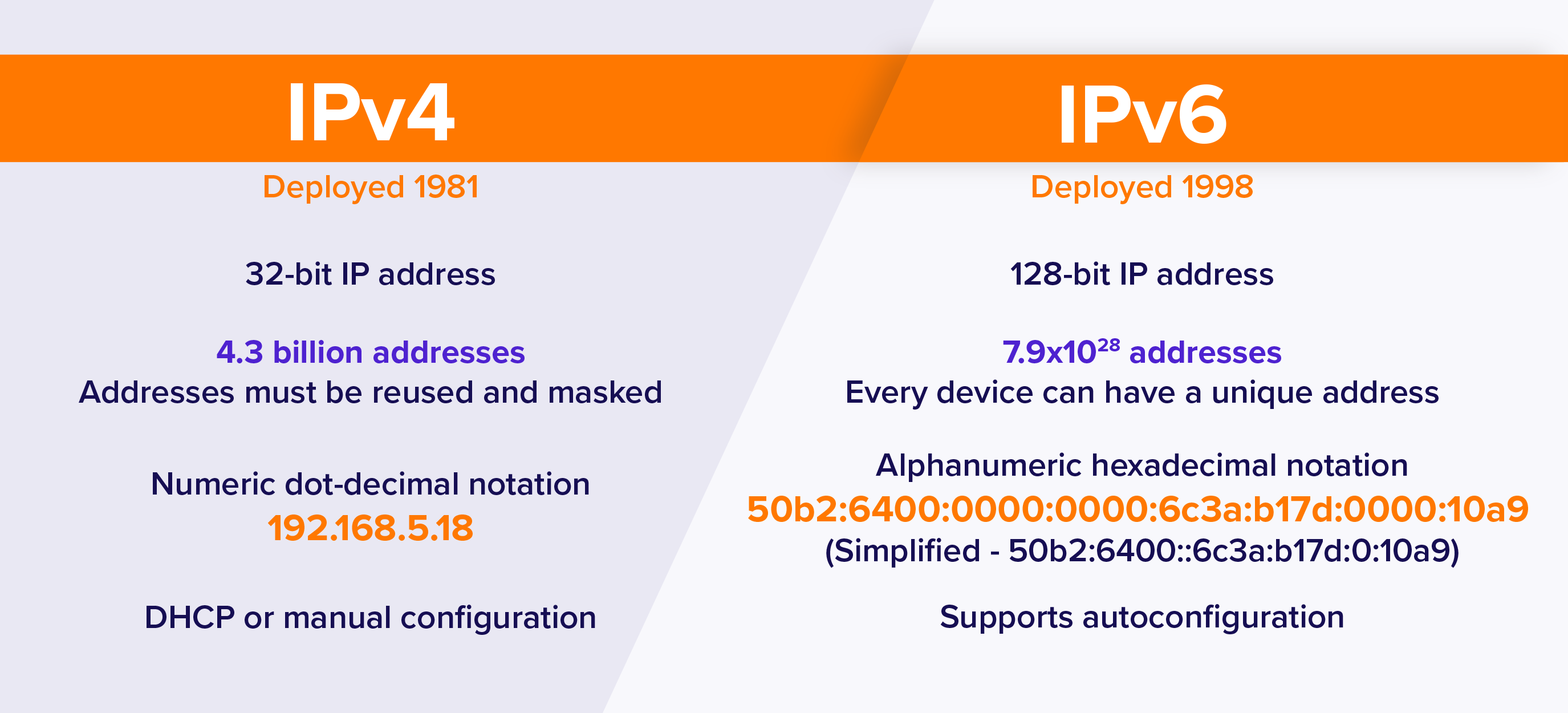What is v4 and v6 IP?
Summary of the Article: IPv4 vs IPv6
IPv4 and IPv6 are different versions of the Internet Protocol (IP). IPv4 uses a 32-bit address length, while IPv6 uses a 128-bit address length. To check if your IP is v4 or v6, you can use https://v4.i-p.show for IPv4 supported devices and https://v6.i-p.show for IPv6 supported devices. IPv4 and IPv6 are both part of the network layer in the OSI model.
An IPv4 address is a 32-bit number that uniquely identifies a network interface on a machine. It is typically written in decimal digits, with four 8-bit fields separated by periods. On the other hand, an IPv6 address is a numeric label used to identify and locate a network interface participating in a computer network. IPv6 addresses consist of eight 16-bit fields separated by colons.
IPv6 is the successor to IPv4 and is the sixth revision of the Internet Protocol. It is used to identify and route online traffic, addressing the issue of IPv4 address depletion. While IPv6 is mandatory for some Windows versions, it is not recommended to disable it as it may cause certain components to malfunction. If needed, it is recommended to prefer IPv4 over IPv6 in prefix policies.
Below are some frequently asked questions about IPv4 and IPv6:
- What is IP addressing v4 and v6?
IPv4 is the fourth version of the Internet Protocol, with a 32-bit address length. IPv6 is the latest version, with a 128-bit address length.
- How do I know if my IP is v4 or v6?
You can use services like https://v4.i-p.show and https://v6.i-p.show to check if your IP is v4 or v6.
- Which layer has IPv4 v6?
IPv4 and IPv6 are both part of the network layer in the OSI model.
- What is the v4 IP address?
The IPv4 address is a 32-bit number that uniquely identifies a network interface on a machine. It is typically written in decimal digits with four 8-bit fields separated by periods.
- What is IPv6 used for?
IPv6 is used to identify and locate network interfaces participating in a computer network. It is included in packet headers to indicate the source and destination of each packet.
- What does IPv6 stand for?
IPv6 stands for Internet Protocol version 6, which is the successor to IPv4.
- Should I turn off IPv6?
It is not recommended to disable IPv6 as it is a mandatory part of some Windows versions. Disabling it may cause certain components to malfunction.
- What is an example IPv6 address?
An example of an IPv6 address is: 2001:0db8:85a3:0000:0000:8a2e:0370:7334. IPv6 addresses can be represented in various ways, simplifying the representation by eliminating parts of it.
- Does every IPv4 have an IPv6?
No, IPv4 and IPv6 are separate IP schemes. To access IPv6 websites, an IPv4 user’s ISP needs to have an IPv4 to IPv6 NAT (PAT) system in place.
- What is IPv6 used for?
IPv6 is the newest version of the Internet Protocol and is used to address the problem of IPv4 address depletion.
- What is IP address v6?
An IPv6 address is 128 bits in length and consists of eight 16-bit fields separated by colons. Each field contains a hexadecimal number.

What is IP addressing v4 and v6
IPv4 is composed of 32-bit address length and is the fourth version of the Internet Protocol (IP). IPv6 is composed of 128-bit address length and is the latest updated version of the Internet Protocol (IP).
Cached
How do I know if my IP is v4 or v6
By using I-P. show, you can check whether you are: On an IPv4 supported device here: https://v4.i-p.show. On an IPv6 supported device here: https://v6.i-p.show.
Cached
Which layer has IPv4 v6
Network layer
IPv6
| Communication protocol | |
|---|---|
| IPv6 header | |
| Based on | IPv4 |
| OSI layer | Network layer |
| RFC(s) | 2460, 8200 |
What is the v4 IP address
The IPv4 address is a 32-bit number that uniquely identifies a network interface on a machine. An IPv4 address is typically written in decimal digits, formatted as four 8-bit fields that are separated by periods.
What is IPv6 used
An Internet Protocol Version 6 address (IPv6 address) is a numeric label that is used to identify and locate a network interface of a computer or a network node participating in a computer network using IPv6. IP addresses are included in the packet header to indicate the source and the destination of each packet.
What does IPv6 stand for
Internet Protocol version 6
IPv6 (Internet Protocol version 6) is the sixth revision to the Internet Protocol and the successor to IPv4.
Should I turn off IPv6
Internet Protocol version 6 (IPv6) is a mandatory part of Windows Vista and Windows Server 2008 and newer versions. We do not recommend that you disable IPv6 or its components. If you do, some Windows components may not function. We recommend using Prefer IPv4 over IPv6 in prefix policies instead of disabling IPV6.
What is an example IPv6 address
An example of an IPv6 address is: 2001:0db8:85a3:0000:0000:8a2e:0370:7334. The standards provide flexibility in the representation of IPv6 addresses. The full representation of eight four-digit groups may be simplified by several techniques, eliminating parts of the representation.
Does every IPv4 have an IPv6
No, they are totally separate IP schemes. For an IPv4 user to get to an IPv6 website the IPv4 users ISP would need to have an IPv4 to IPv6 NAT (PAT technically) system in place to translate the traffic between the two. Same goes for IPv6 users trying to get to an IPv4 website.
What is IPv6 used for
IPv6 is the newest version of internet protocol formulated by the IETF, which helps identify and local endpoint systems on a computer network and route online traffic while addressing the problem of IPv4 address depletion due to prolonged internet use worldwide.
What is IP address v6
An IPv6 address is 128 bits in length and consists of eight, 16-bit fields, with each field bounded by a colon. Each field must contain a hexadecimal number, in contrast to the dotted-decimal notation of IPv4 addresses. In the next figure, the x's represent hexadecimal numbers.
What is a sample IP address for v6
The following are examples of valid IPv6 (normal) addresses: 2001:db8:3333:4444:5555:6666:7777:8888. 2001:db8:3333:4444:CCCC:DDDD:EEEE:FFFF.
Should I keep IPv6 on or off
We do not recommend that you disable IPv6 or its components. If you do, some Windows components may not function. We recommend using Prefer IPv4 over IPv6 in prefix policies instead of disabling IPV6.
Should IPv6 be turned on
Some users disable IPv6 on routers or devices because they don't run any applications or services that rely on IPv6. Disabling IPv6 is also common when troubleshooting network issues. However, service providers discourage users from disabling IPv6 and warn that it may cause connectivity problems.
Do I want IPv6 on or off
We do not recommend that you disable IPv6 or its components. If you do, some Windows components may not function. We recommend using Prefer IPv4 over IPv6 in prefix policies instead of disabling IPV6.
Should I enable IPv6 on my Wi-Fi
When possible, it is better to keep both IPv4 and IPv6 addresses enabled. For example, using only IPv6 can cause some accessibility issues, as only about one third of the internet supports IPv6 addresses. Likewise, disabling IPv6 can cause certain problems, especially if your router is already using an IPv6 address.
Should I use IPv4 or IPv6 on my router
Based on the content mentioned above, IPv6 is extremely important for the long-term health of the Internet. Switching from IPv4 to IPv6 will give the Internet a much larger pool of IP addresses. It should also allow every device to have its own public IP address, rather than be hidden behind a NAT router.
Should I enable both IPv4 and IPv6 on my router
When possible, it is better to keep both IPv4 and IPv6 addresses enabled. For example, using only IPv6 can cause some accessibility issues, as only about one third of the internet supports IPv6 addresses. Likewise, disabling IPv6 can cause certain problems, especially if your router is already using an IPv6 address.
What is the difference between IPv4 and IPv6 example
The main difference between IPv4 and IPv6 is the address size of IP addresses. The IPv4 is a 32-bit address, whereas IPv6 is a 128-bit hexadecimal address. IPv6 provides a large address space, and it contains a simple header as compared to IPv4.
What is an example of a IPv4 address
IP (version 4) addresses are 32-bit integers that can be expressed in hexadecimal notation. The more common format, known as dotted quad or dotted decimal, is x.x.x.x, where each x can be any value between 0 and 255. For example, 192.0. 2.146 is a valid IPv4 address.
What is an example of a v4 IP address
IP (version 4) addresses are 32-bit integers that can be expressed in hexadecimal notation. The more common format, known as dotted quad or dotted decimal, is x.x.x.x, where each x can be any value between 0 and 255. For example, 192.0. 2.146 is a valid IPv4 address.
Should I turn on IPv4 or IPv6
IPv6 is faster than IPv4 in network devices because it lacks network-address translation (NAT). Using IPv6 is a better choice for people that require high speed for their network processing.
Should I enable IPv6 on my WIFI
When possible, it is better to keep both IPv4 and IPv6 addresses enabled. For example, using only IPv6 can cause some accessibility issues, as only about one third of the internet supports IPv6 addresses. Likewise, disabling IPv6 can cause certain problems, especially if your router is already using an IPv6 address.
Should IPv6 be on or off router
Some users disable IPv6 on routers or devices because they don't run any applications or services that rely on IPv6. Disabling IPv6 is also common when troubleshooting network issues. However, service providers discourage users from disabling IPv6 and warn that it may cause connectivity problems.
What happens if I enable IPv6 on my router
Additional IPv6 benefits
More efficient packet routing thanks to a prefix allocation scheme that allows data to flow more efficiently through routers on the internet. More flexible address scoping rules designed to support a broader range of usage scenarios for all types of networks.



